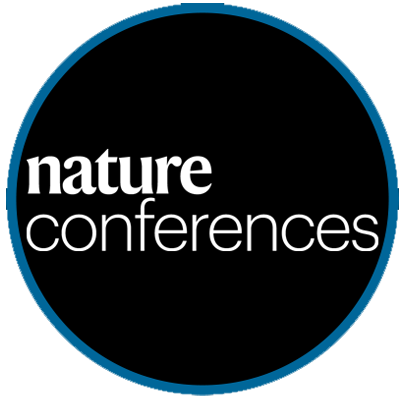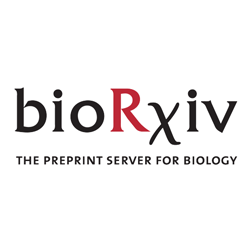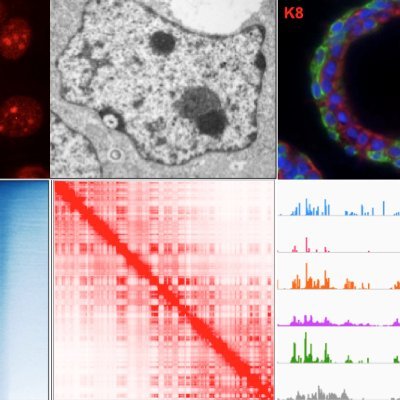
Mitch Guttman
@mitchguttman
Followers
3K
Following
969
Media
60
Statuses
308
Molecular biologist interested in non-coding RNAs, nuclear organization, and gene regulation. Professor at Caltech
Los Angeles, CA
Joined May 2015
Gene regulation involves thousands of proteins that bind DNA, yet comprehensively mapping these is challenging. Our paper in @NatureGenet describes ChIP-DIP, a method for genome-wide mapping of hundreds of DNA-protein interactions in a single experiment. https://t.co/0aINMj2MTu
nature.com
Nature Genetics - ChIP-DIP (ChIP done in parallel) is a highly multiplex assay for protein–DNA binding, scalable to hundreds of proteins including modified histones, chromatin regulators and...
8
190
692
October 10- Deadline to submit abstracts and grab a early bird registration for our event on nucleic acid medicine with these experts. Learn more> https://t.co/RIGVMQUPak
@ArtKrieg @yegracechen @HowardYChang @mbarnalab @MRC_TU @mitchguttman @Caltech @EliLillyandCo @Alnylam
0
6
12
Inspired by condensates that form on specific DNA loci, we ask: Can we design multicomponent fluids to form distinct condensates on diff. surfaces? i.e., perform a type of information processing (surface classification) through condensation! https://t.co/Z8zRloSpHQ (1/2)
1
9
30
In the latest issue! SPIDR enables multiplexed mapping of RNA-protein interactions and uncovers a mechanism for selective translational suppression upon cell stress
cell.com
SPIDR, a massively multiplexed method that simultaneously maps dozens of RNA-binding proteins to their RNA targets at single-nucleotide resolution, uncovers new RNA-protein interactions and provides...
0
19
91
“What’s past is prologue” — excited about chromatin recording by synthetically engineering recruitment of adenine methyltransferases in living cells. Will enable one to correlate past states with subsequent fate decisions. New work from the virtuosic @yodai_takei See thread.
I'm excited to share our new preprint on LagTag, a method that recovers both past and present chromatin states from the same mammalian cells. https://t.co/GEGQpN0Ff0
2
23
137
How embryos stay “on time” as they grow? Happy to share our recent publication: Quantitative modeling of mRNA degradation reveals tempo-dependent mRNA clearance in early embryos (1/7) https://t.co/zhudkLmFkp
academic.oup.com
Abstract. As embryos transition from maternal to zygotic control, precise clearance of pre-loaded maternal mRNAs is essential for initiating new zygotic ge
5
14
58
(1/n) Excited to share our new preprint! We uncover that RNA actively promotes nucleation and function of pathogenic condensates, amplifying locus-specific oncogenic transcription and promoting tumorigenesis. #epigenetics #condensates #cancer #RNA
biorxiv.org
Aberrant chromatin-associated condensates have emerged as drivers of transcriptional dysregulation in cancer, yet the mechanisms regulating their formation and function remain poorly understood....
3
14
55
Happy to share our new SPIDR method for mapping RBPs at scale out in @CellCellPress!
Many proteins bind RNA, yet we still don’t know what RNAs most bind because methods map one RBP at a time. In @CellCellPress, with the Jovanovic lab, we describe SPIDR – a method for mapping the RNA binding sites of dozens of RBPs in a single experiment. https://t.co/Zs2Rn35D3s
0
3
25
This work was led by co-first authors Jimmy Guo (@jimmykguo) and Erica Wolin with support from amazing teams from our lab @caltech and the Jovanovic lab @Columbia and @Jayquerido with financial support from @NIH @NSF @genome_gov @GenomeTDCC.
1
0
6
We used SPIDR to identify mTOR-dependent changes and observed that 4EBP1 showed a dramatic increase in binding upon mTOR inhibition specifically at mRNAs containing a TOP-motif, suggesting a new model for how translational repression is selectively achieved upon mTOR inhibition.
1
0
3
We identified an interaction between LARP1 and 18S rRNA located within the mRNA channel entry site on the 40S small ribosomal subunit and @Jayquerido resolved this structure at 2.8 Å using single-particle cryo-EM.
1
0
2
Single nucleotide binding maps generated by SPIDR can map known RNP structures at atomic resolution and identify novel components within RNP structures.
1
0
3
We show that SPIDR generates high quality data across a diverse range of RBPs, including transcription, splicing, translation, and miRNA biogenesis, all within a single experiment.
1
0
2
SPIDR uses a simplified split-and-pool based strategy to increase the throughput of CLIP by two orders of magnitude. SPIDR enables the rapid generation of consortium-level datasets within any molecular biology lab without the need for specialized training or equipment.
1
0
3
Many proteins bind RNA, yet we still don’t know what RNAs most bind because methods map one RBP at a time. In @CellCellPress, with the Jovanovic lab, we describe SPIDR – a method for mapping the RNA binding sites of dozens of RBPs in a single experiment. https://t.co/Zs2Rn35D3s
9
116
403
Excited that our nucleolus mapping paper just came out today in Nature! Truly an amazing study from even more amazing due of @sofiquinodoz & @jiang_lifei w/ @LafontaineLab & Sebastian Klinge and other fantastic co-authors
nature.com
Nature - Spatially segregated rRNA processing dictates nucleolar morphology and drives outward progression of pre-ribosomal RNA through nucleolar phases.
Excited to share a new preprint! (1)🔬The nucleolus is the most prominent nuclear condensate, with a fascinating multilayered liquid-like structure, and is the site of ribosome biogenesis. But how does this multiphase architecture form and function? https://t.co/xKP9tGFFlQ
3
37
143
Stop the doom scrolling! A new 🗞️ from my lab, describing one of our flagship projects of many years we are super excited to share: "Inducible formation of fusion transcripts upregulates haploinsufficient CHD2 gene expression". A 🧵 https://t.co/935AvtPL8S
2
32
110
Very excited to share our latest work in @MolecularCell showing NPM1 stabilizing the association of nucleolus associated domains (NADs) and recruiting G9a to establish their repressive chromatin states. https://t.co/3JLKZ04eYx
3
25
85
Happy to share our recent work showing bulk transport of speckle material between nuclear speckles within dynamic, multi-phase, linear connections. Nonrandom interchromatin trafficking through dynamic multiphase speckle connections
biorxiv.org
Nuclear speckles (NS) enhance the expression of NS-associated genes, possibly by elevating local levels of factors involved in multiple steps of gene expression. While dozens of large NS are distri...
0
8
31
We've designed an RNA-targeted small molecule that reduces toxic 4R tau protein linked to FTDP-17. This orally bioavailable and brain-penetrant compound shows promise in mitigating cellular pathologies and behavioral phenotypes in mouse models. Link here https://t.co/wpDqFLyNiI
biorxiv.org
Frontotemporal dementia with parkinsonism linked to chromosome 17 (FTDP-17) is caused by the aberrant alternative pre-mRNA splicing of microtubule-associated protein tau ( MAPT ) exon 10, the...
4
16
113



















